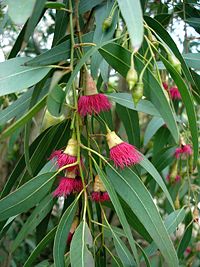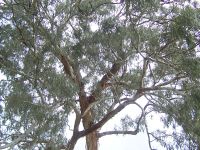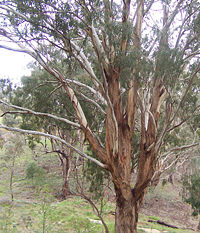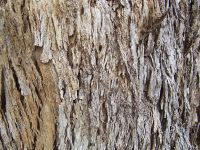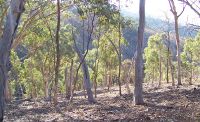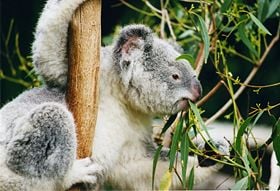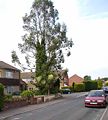Eucalyptus
| Eucalyptus | ||||||||||||
|---|---|---|---|---|---|---|---|---|---|---|---|---|
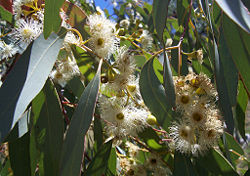 Eucalyptus melliodora foliage and flowers | ||||||||||||
| Scientific classification | ||||||||||||
| ||||||||||||
| Species | ||||||||||||
|
About 800 |
Eucalyptus is a diverse genus of trees (rarely shrubs), the members of which dominate the tree flora of Australia. There are more than 800 species of Eucalyptus, mostly native to Australia, with a very small number found in adjacent parts of New Guinea and Indonesia. Eucalypts,as they are also called, can be found in almost every part of the continent, adapted to all of Australia's climatic conditions; in fact, no other continent is so characterised by a single genus of tree as Australia is by eucalyptus.
Description
The most readily recognisable characteristics of Eucalyptus species are the distinctive flowers and fruits. The name Eucalyptus means "well-covered"; it describes the bud cap (technically called an operculum). This cap forms from modified petals and falls off as the flower opens. Thus flowers have no petals, decorating themselves instead with many showy stamens. The woody fruits are roughly cone-shaped and have valves at the end which open to release the seeds.
A small genus of similar trees, Angophora, has also been known since the 18th century. In 1995 new evidence, largely genetic, indicated that some prominent eucalypt species were actually more closely related to Angophora than to the other eucalypts; they were split off into the new genus Corymbia. Although separate, the three groups are allied and it remains acceptable to refer to the members of all three genera Angophora, Corymbia and Eucalyptus as "eucalypts".
Nearly all eucalypts are evergreen but some tropical species lose their leaves at the end of the dry season. As in other members of the Myrtle family, eucalypt leaves are covered with oil glands. The copious oils produced are an important feature of the genus. Eucalypts also exhibit leaf dimorphism. When young, their leaves are opposite, oval to roundish, and occasionally without a petiole. When one to a few years old, the leaves become alternate, lanceolate to falcate (sickle-shaped), quite slender and pendulous with longer petioles. The adult leaves of most species, as well as the juvenile leaves of some, are the same on both sides, lacking the distinction between upper and lower surfaces shown by the leaves of most plants. Most species do not flower until adult foliage starts to appear; E. cinerea and E. perriniana are notable exceptions.
Eucalyptus species have various types of bark. In smooth-barked trees most of the bark is shed, leaving a smooth surface that is often colorfully mottled. With rough-barked trees the dead bark persists on the tree and dries out. Many trees, however, have smooth bark at the top but rough bark on the trunk or its bottom.
Many eucalypts are called "gum trees" because of a sticky, gum-like substance they exude from their trunks. Some of the other common names for different eucalypts include:
- Apple - A name used by early European settlers due to a similarity in appearance of some plants to apple trees (eg. Angophora bakeri, "Narrow-leaved apple")
- Ash - Timber is similar to the European ash trees (eg. Eucalyptus regnans, "Mountain ash")
- Blackbutt - The lower part of the trunk has persistent bark which is usually black due to past fires (eg. Eucalyptus pilularis, "Blackbutt")
- Bloodwood - Timber often has pockets of a dark red gum known as kino (eg. Corymbia eximia, "Yellow bloodwood")
- Box - Bark is retained on the tree and is short fibred; plates of bark may shear off with age (eg. Eucalyptus melliodora ("Yellow box")
- Ironbark - Bark is retained on the tree and is hard and deeply furrowed (eg. Eucalyptus crebra, "Narrow-leaved ironbark")
- Mallee - Multi-stemmed trees, usually fairly small in height (eg. Eucalyptus albida, "White-leaved mallee")
- Peppermint - The oil in the leaves has a peppermint-like aroma (eg. Eucalyptus dives, "Broad-leaved peppermint")
- Ribbon Gum - Bark is deciduous and is shed in long strips which often hang from the branches (eg. Eucalyptus viminalis, "Ribbon gum")
- Scribbly Gum - Bark is deciduous and the smooth trunk is marked with "scribbles" caused by an insect larva (eg. Eucalyptus sclerophylla, "Scribbly gum")
- Stringybark - Bark is retained in long fibres which can be pulled off in "strings" (eg. Eucalyptus eugenioides, "Thin-leaved stringybark")[1]
Today, specimens of the Australian Mountain Ash, Eucalyptus regnans, are among the tallest trees in the world at up to 92 metres in height [1] and the tallest of all flowering plants; other taller trees such as the Coast Redwood are all conifers. There is credible evidence however that at the time of European settlement of Australia some Mountain Ash were perhaps the tallest plants in the world.
Most eucalypts are not tolerant of frost, or only tolerate light frosts down to -3°C to -5°C; the hardiest, are the so-called Snow Gums such as Eucalyptus pauciflora which is capable of withstanding cold and frost down to about -20°C. Two sub-species, E. pauciflora niphophila and E. pauciflora debeuzevillei in particular are even hardier and can tolerate even quite severe continental type winters.
Several other species, especially from the high plateau and mountains of central Tasmania such as E. coccifera, E. subcrenulata, and E. gunnii have produced extreme cold hardy forms and it is seed procured from these genetically hardy strains that are planted for ornament in colder parts of the world.
The coolibah trees, referred to in the song "Waltzing Matilda", are eucalypts E. coolabah and E. microtheca.
Animal Relationships
Eucalypts provide food for a large number of animals including koalas, cockatoos, and many insects. Many others live in the eucalyptus forests. It has been estimated that 20 percent of Australia's mammals are arboreal, living in trees. [2]
Eucalyptus and Humans
Hazards
Eucalypts have a habit of dropping entire branches off as they grow. Eucalyptus forests are littered with dead branches. The Australian Ghost Gum Eucalyptus papuana is also termed the "widow maker", due to the high number of pioneer tree-felling workers who were killed by falling branches. Many deaths were actually caused by simply camping under them, as they shed whole and very large branches to conserve water during periods of drought. For this reason, one should never camp under an overhanging branch. This may be the real reason behind the drop bear story told to children - the idea is to keep them away from under dangerous branches.
Fire
On warm days vapourised eucalyptus oil rises above the bush to create the characteristic distant blue haze of the Australian landscape. Eucalyptus oil is highly flammable (trees have been known to explode) and bush fires can travel easily through the oil-rich air of the tree crowns. The dead bark and fallen branches are also flammable. Eucalypts are well adapted for periodic fires, in fact most species are dependent on them for spread and regeneration, both from reserve buds under the bark, and from fire-germinated seeds sprouting in the ashes.
Eucalypts originated between 35 and 50 million years ago, not long after Australia-New Guinea separated from Gondwana, their rise coinciding with an increase in fossil charcoal deposits (suggesting that fire was a factor even then), but they remained a minor component of the Tertiary rainforest until about 20 million years ago when the gradual drying of the continent and depletion of soil nutrients led to the development of a more open forest type, predominantly Casuarina and Acacia species. With the arrival of the first humans about 50 thousand years ago, fires became much more frequent and the fire-loving eucalypts soon came to account for roughly 70% of Australian forest.
Cultivation and uses
Eucalypts have many uses which have made them economically important trees. Due to their fast growth the foremost of these is the wood. They provide many desirable characteristics for use as ornament, timber, firewood and pulpwood. Fast growth also makes eucalypts suitable as windbreaks.
The roots absorb lots of water and so eucalypts have been planted (or re-planted) to lower the water table and reduce soil salination. Eucalypts have also been used as a way of reducing malaria by draining the soil in Algeria, Sicily[2] and also in Europe and California[3]. Drainage removes swamps which provide a habitat for mosquito larvae.
Eucalyptus oil is readily steam distilled from the leaves and can be used for cleaning, deodorising, and in very small quantities in food supplements; especially sweets, cough drops and decongestants.
The nectar of some eucalypts produces high quality honey. Perhaps the Karri and the Yellow box are the best known.
The ghost gum's leaves were used by Aborigines to catch fish. Soaking the leaves in water releases a mild tranquiliser which stuns fish temporarily.
Plantation and ecological problems
Eucalypts were first introduced to the rest of the world by Sir Joseph Banks, botanist on the Cook expedition in 1770. They have subsequently been introduced to many parts of the world, notably California, Brazil, Morocco, Portugal, South Africa, Israel and Galicia. Several species have become invasive and are causing major problems for local ecologies. In Spain, they have been planted in pulpwood plantations, replacing native oak woodland. As in other such areas, while the original woodland supports numerous species of native animal life (insects, birds, salamanders, etc.), the eucalypt groves are inhospitable to the local wildlife which is not adapted to them, leading to silent forests and the decline of wildlife populations. On the other hand, eucalypts are the basis for several industries, such as sawmilling, pulp, charcoal and others.
Eucalypts have been imported into California, primarily for use in windbreaks enclosing large tracts of arid western San Joaquin valley farmland. While some of the Australian gumwoods make beautiful furniture wood, resembling Teak, an inappropriate type for this purpose was imported into California. This type is neither attractive as a veneer (its color varies from yellowish-gray to grayish-green), useful as lumber (it tends to warp and split after cutting), or even thought well of as firewood (oak, nutwoods and fruitwoods are the preferred commercial firewoods in Northern California).
Their presence in the Oakland-Berkeley hills in California has led to periodic wildfires that have spread into dense urban areas, and since these rapidly regenerate from root sprouts the problem will continue until they are completely removed. Severe cold for a period of several weeks has killed off large stands, which had to be immediately removed to eliminate the consequent severe fire hazard. The shedding of bark creates an open and flammable forest litter that also snags on limbs and so provides a direct fire path from forest floor to tree crown. In some ecologicaly sensitive areas such as Angel Island in San Francisco Bay, an eradication program is underway to completely restore the original oak-studded grasslands.
ReferencesISBN links support NWE through referral fees
- ↑ J.E. Hickey, P. Kostoglou, G.J. Sargison. Tasmania's Tallest Trees. Forestry Tasmania. Retrieved 2005-01-27.
- ↑ Mrs. M. Grieve. A Modern Herbal:Eucalyptus. Retrieved 2005-01-27.
- ↑ Santos, Robert L. The Eucalyptus of California. Alley-Cass Publications. Retrieved 2005-01-27.
See also
- Angophora
- Corymbia
External links
- EUCLID Sample, CSIRO
- The Eucalyptus Page
- EucaLink
- The Hardy Eucalyptus Page
- Eucalyptus globulus Diagnostic photos: tree, leaves, bark
- http://www.anbg.gov.au/projects/eucalypts/eucalypts.html
- [3]eucalyptus as an energy source
- [4]Eucalyptus at UCSD
- [5]invasive
- [6]medicine
- [7]Eucalyptus in California
Photo gallery
- Eucalyptus forest.jpg
Eucalyptus forest in East Gippsland, Victoria. Mostly Eucalyptus albens (white box).
Corymbia tree, growing in Melbourne, Australia
Credits
New World Encyclopedia writers and editors rewrote and completed the Wikipedia article in accordance with New World Encyclopedia standards. This article abides by terms of the Creative Commons CC-by-sa 3.0 License (CC-by-sa), which may be used and disseminated with proper attribution. Credit is due under the terms of this license that can reference both the New World Encyclopedia contributors and the selfless volunteer contributors of the Wikimedia Foundation. To cite this article click here for a list of acceptable citing formats.The history of earlier contributions by wikipedians is accessible to researchers here:
The history of this article since it was imported to New World Encyclopedia:
Note: Some restrictions may apply to use of individual images which are separately licensed.
